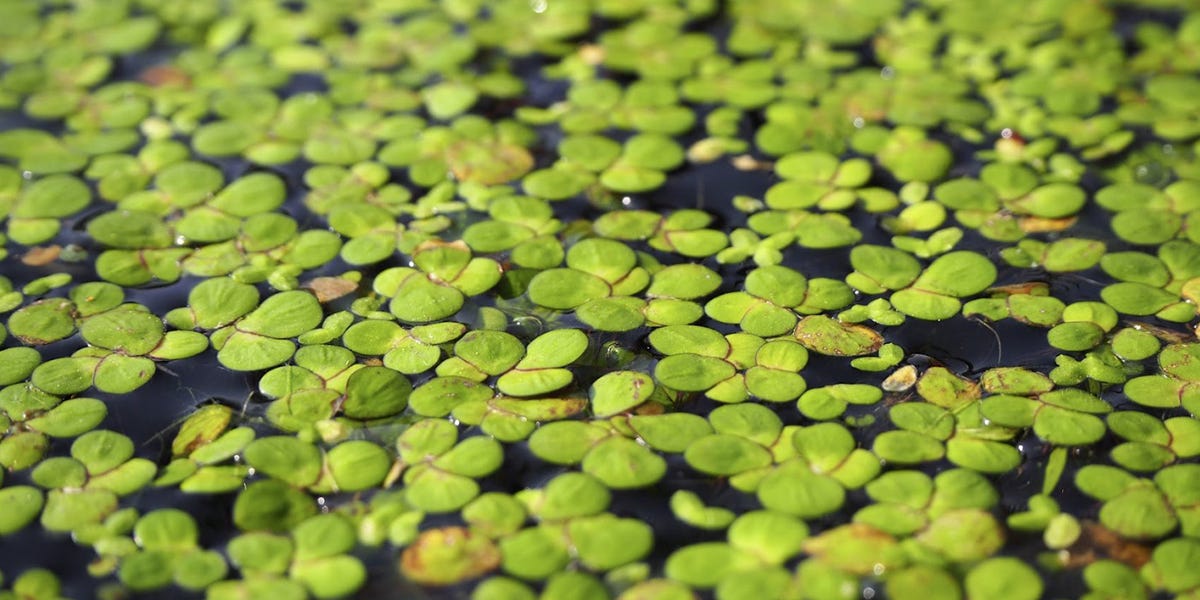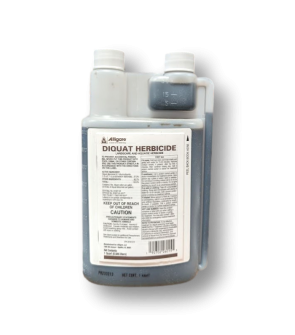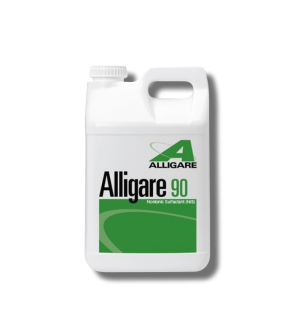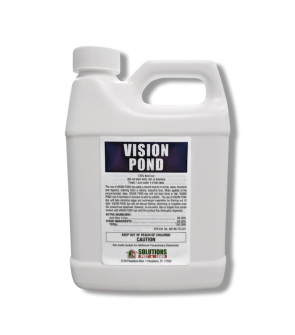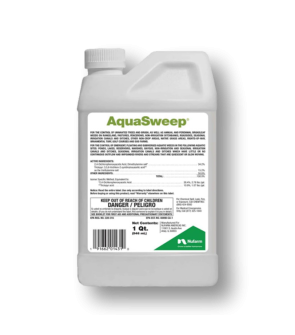Gain access to personalized product screening, the best pricing, rewards, and more!
Most Effective Products
Duckweed Control: How To Get Rid of Duckweed
This page is a general DIY guide for controlling duckweed. Using the suggested products and methods, you can control duckweed. Follow this DIY article and use the recommended products, and we guarantee 100% control of duckweed.
Duckweed, also known as water lentils or water lenses are free-floating pond weed notorious for spreading at an alarming rate and can infest a pond or quiet lake in a matter of days once established. Duckweed can be a major problem for pond owners due to its tendency for turning an aesthetically pleasing pond into an ugly mess.
Duckweed is known to spread onto ponds by migrating birds who have the plant stuck on their feathers. If left alone, duckweed causes issues such as decreasing oxygen levels necessary for fish and desirable aquatic plants to survive.
If you have duckweed growing on your pond or aquatic property, you can put a stop to it with the help of this informative DIY guide. Using our professional aquatic herbicides, you can get rid of duckweed quickly and affordably.
Identification

Before proceeding with a treatment program, you must be certain you are facing a duckweed infestation. Careless identification can lead to using the wrong treatment methods, which can be a waste of time and money. Below are the following characteristics to help you understand what duckweed looks like.
- Duckweed is a tiny, free-floating aquatic plant that often carpets the surface of still or slow-moving freshwater bodies. Each individual duckweed plant consists of a single, round, green leaf-like structure called a frond, usually 1/5 inches wide. This frond floats on the water’s surface, while one or more thin roots, about 1/2 inches long, dangle below in the water.
- The duckweed inflorescence is extremely small and rarely observed. It consists of two microscopic staminate (male) flowers and one tiny pistillate (female) flower, all enclosed in a small, pouch-like sac on the surface of the frond. Because of its minute size and the plant’s preference for vegetative reproduction, flowering is uncommon and often overlooked.
- Due to its green coloration its often mistaken for algae. Unlike algae, duckweed is a true plant, meaning it has roots, leaves (even if tiny), and can produce flowers and seeds. Algae, on the other hand, is a broad group of mostly simple, non-flowering organisms that can be single-celled or multicellular. In short, algae are simpler organisms without true plant parts, often looking like slimy or filamentous growth in water.
Use our description and image to help you identify whether the plant you see is duckweed. If you are having trouble, contact us and we will help you correctly ID the plant and offer effective control recommendations.
Inspection

Once you confirm that you are dealing with duckweed, you can move on to inspection. During this phase, you will locate areas where duckweed is present and observe the conditions that allow it to thrive. This information will help you know where to focus your herbicide application.
Where to Inspect
Duckweed typically grows on the surface of still or slow-moving freshwater bodies such as ponds, lakes, marshes, and quiet backwaters of rivers or streams. It thrives in nutrient-rich waters that are rich in nitrogen and phosphorus, often in areas with ample sunlight and little water movement.
What to Look For
Duckweed consists of small, oval or round leaf-like structures, often no larger than a grain of rice, that float closely together, sometimes forming dense mats that look like a green carpet.
You might notice the water surface looks almost completely covered, especially in calm areas, with little open water visible. Additionally, duckweed mats can sometimes trap debris or create a slight odor if the plants start to decay.
Early signs include scattered patches of these tiny plants drifting or clustering near the shore or in sheltered areas before they spread widely across the pond or water body.
Treatment
Before handling any aquatic herbicide it is essential to first put on the proper personal protective equipment (PPE) for safety.
Our top recommended product to treat duckweed is Alligare Diquat Herbicide.
Alligare Diquat Herbicide is a fast-acting, non-selective aquatic and terrestrial weed killer designed to control floating, submerged, and emergent weeds, as well as unwanted grasses and broadleaf plants. Powered by pyrazinediium and diquat dibromide, this professional-grade herbicide is ideal for use in aquatic environments, industrial sites, right-of-ways, and more.
Step 1: Prepare and Mix

To do this, measure the length, width, and average depth of the water body in feet then divide by 43,560 (Length (ft) x Width (ft) x Average Depth (ft) / 43,560 = Acre-feet).
To control duckweed, apply 1 to 2 gallons of Alligare Diquat Herbicide per acre.
For spot treatments using Alligare Diquat Herbicide, the recommended application rate is 2 quarts of product per 100 gallons of water, which creates a 0.5% solution.
To improve herbicide effectiveness, an approved aquatic wetting agent (also known as a surfactant) such as Alligare 90 should be added at a rate of 0.25% to 1.0% by volume. This equates to adding 1 quart to 1 gallon of surfactant per 100 gallons of water.
Use a backpack sprayer, spray rig, or boat-mounted sprayer equipped with a flat-fan or adjustable nozzle. Make sure the sprayer is clean and calibrated for even coverage.
Step 2: Apply Alligare Diquat Herbicide
Once the herbicide and surfactant have been properly mixed at the recommended rates, the solution is ready for application.
Apply the spray directly to the surface of the duckweed, ensuring full coverage. If submerged, spray on the water surface directly above the weed.
For water bodies with dense weed growth, apply Alligare Diquat Herbicide to only one-third to one-half of the total area at a time.
This staged approach helps prevent a sudden drop in dissolved oxygen levels caused by the rapid decomposition of large amounts of vegetation, which can be harmful to fish and other aquatic life.
If a second application is needed to treat remaining areas, wait at least 14 days between treatments to allow the ecosystem to stabilize before continuing with further applications.
Prevention
Once duckweed has been eliminated from your property, you will need to implement preventative measures to ensure that this aquatic weed does not return.
- Duckweed thrives in nutrient-rich water, especially where nitrogen and phosphorus are high. Reduce runoff from fertilized lawns, gardens, or farm fields. Avoid dumping grass clippings, leaves, or animal waste near the water. Use buffer strips of vegetation around the pond to absorb nutrients before they enter the water.
- Increasing water circulation through the use of aerators, fountains, or small waterfalls also helps discourage duckweed growth, as it prefers still, stagnant water.
- Regular manual removal of any visible duckweed using nets or rakes can prevent small patches from turning into full infestations. Continue to monitor the area and make applications with Alligare Diquat Herbicide as new growth appears.
- Using a pond dye is an effective, preventative method to help control and reduce the growth of duckweed. Vision Pond Dye works by limiting sunlight penetration into the water, which duckweed needs for photosynthesis and rapid growth. By coloring the water, the blue dye creates a shaded environment that discourages the spread of duckweed and other algae without harming fish, plants, or wildlife when used as directed. It is most effective when applied early in the season, before duckweed becomes established. One quart of Vision Pond Dye treats 1 acre of water that is 4 to 6 feet deep. Pour the pond dye over the edge directly into the body of water, and the water's natural movement will disperse the dye.
Key Takeaways
What is Duckweed?
- Duckweed is a small invasive weed that has a knack for covering up an entire pond service with its rapid growth.
How to Get Rid of Duckweed
- Alligare Diquat Herbicide is the best recommendation to manage duckweed. We also suggest mixing it with Alligare 90 to increase the herbicides rate of control over weeds.
Preventing Duckweed
- A combination of cultural practices, regular on-going applications with Alligare Diquat Herbicide and Vision Pond Dye can deter duckweed from growing again on the water body.






